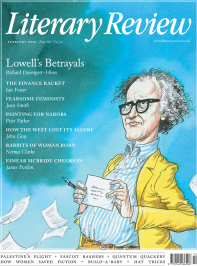Richard Vinen
History Boys
Conservative Revolutionary: The Lives of Lewis Namier
By D W Hayton
Manchester University Press 454pp £25
Sir John Plumb: The Hidden Life of a Great Historian
By Neil McKendrick
Edward Everett Root 274pp £29.99
The uncomfortably intense manner, the thick foreign accent, the dropping of the names of influential friends, the ostentatious spending with no obvious sign of steady income, the insistence to anyone willing to listen – and some who are not – that the speaker is about to revolutionise his academic field: those who spent any time in the old reading room of the British Museum will recognise the type. But Lewis Namier was not just another lonely eccentric. Born in Russian-ruled Poland to a Jewish family in 1888, his extraordinary abilities took him to Oxford and then, during the First World War and its aftermath, to the Foreign Office. The authorities, possibly Churchill himself, recalled Namier to service in 1939, when he became an intelligence adviser at the Admiralty. Until he got a chair at Manchester in 1931, he had no permanent academic post. But, living on grants and loans for much of the 1920s, he wrote two books, The Structure of Politics at the Accession of George III (1929) and England in the Age of the American Revolution (1930), that were marked by close attention to detail, particularly to the material interests of MPs. G M Trevelyan, an exponent of the ‘Whig’ interpretation of history that Namier was seeking to displace, generously hailed the new ‘Namierite’ way of doing history. However, Namier did not, at first, found a school. His closest associate in the 1930s was A J P Taylor, who was no one’s disciple. It was only after 1945 that large numbers of other historians began to apply what they took to be Namierite techniques. In those distant days when a serving prime minister might spend the weekend reading, Harold Macmillan noted that Theodore Zeldin’s The Political System of Napoleon III (1958) was ‘in the Namier tradition’.
Namier was at his best in adversity: it was typical of him that, having been tormented for much of his life by insomnia, he slept soundly during the London Blitz. Success did not suit him. Once his professional position was secure, he published less. ‘Namierism’ became an ossified and rigid system, which was why it seemed such an easy target in the 1960s. Critics often forgot that Namier had begun as a rebel against orthodoxy rather than as a font of academic authority. By later standards, his work could seem Anglocentric and elitist, though one of his objectives was to explain the origins of the United States and his conception of the political elite was much wider than that of most of his contemporaries.
Most of all, the very flamboyance of Namier’s style provided his critics with ammunition. He referred to the political notions of George III as ‘flapdoodle’, which gave rise to a view that he disregarded the significance of all political ideas. This was unfair. He recognised the influence of nationalist, Bolshevik

Sign Up to our newsletter
Receive free articles, highlights from the archive, news, details of prizes, and much more.@Lit_Review
Follow Literary Review on Twitter
Twitter Feed
It wasn’t until 1825 that Pepys’s diary became available for the first time. How it was eventually decrypted and published is a story of subterfuge and duplicity.
Kate Loveman tells the tale.
Kate Loveman - Publishing Pepys
Kate Loveman: Publishing Pepys
literaryreview.co.uk
Arthur Christopher Benson was a pillar of the Edwardian establishment. He was supremely well connected. As his newly published diaries reveal, he was also riotously indiscreet.
Piers Brendon compares Benson’s journals to others from the 20th century.
Piers Brendon - Land of Dopes & Tories
Piers Brendon: Land of Dopes & Tories - The Benson Diaries: Selections from the Diary of Arthur Christopher Benson by Eamon Duffy & Ronald Hyam (edd)
literaryreview.co.uk
Of the siblings Gwen and Augustus John, it is Augustus who has commanded most attention from collectors and connoisseurs.
Was he really the finer artist, asks Tanya Harrod, or is it time Gwen emerged from her brother’s shadow?
Tanya Harrod - Cut from the Same Canvas
Tanya Harrod: Cut from the Same Canvas - Artists, Siblings, Visionaries: The Lives and Loves of Gwen and Augustus John by Judith Mackrell
literaryreview.co.uk